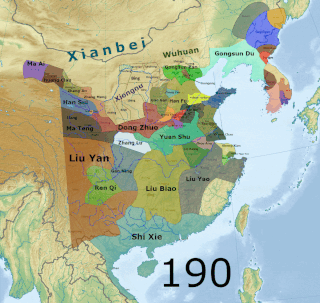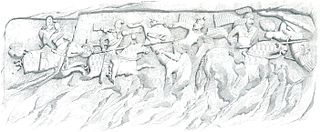Related Research Articles
The 200s decade ran from January 1, 200, to December 31, 209.
The 180s decade ran from January 1, 180, to December 31, 189.
The 190s decade ran from January 1, 190, to December 31, 199.
The 270s decade ran from January 1, 270, to December 31, 279.
Year 217 (CCXVII) was a common year starting on Wednesday of the Julian calendar. At the time, it was known as the Year of the Consulship of Praesens and Extricatus. The denomination 217 for this year has been used since the early medieval period, when the Anno Domini calendar era became the prevalent method in Europe for naming years.

Year 251 (CCLI) was a common year starting on Wednesday of the Julian calendar. At the time, in the Roman Empire, it was known as the Year of the Consulship of Traianus and Etruscus. The denomination 251 for this year has been used since the early medieval period, when the Anno Domini calendar era became the prevalent method in Europe for naming years.
The 210s decade ran from January 1, 210, to December 31, 219.
The 220s decade ran from January 1, 220, to December 31, 229.
The 230s decade ran from January 1, 230, to December 31, 239.
The 240s decade ran from January 1, 240, to December 31, 249.
The 250s was a decade that ran from January 1, 250, to December 31, 259.
Year 255 (CCLV) was a common year starting on Monday of the Julian calendar. At the time, it was known in Rome as the Year of the Consulship of Valerianus and Gallienus. The denomination 255 for this year has been used since the early medieval period, when the Anno Domini calendar era became the prevalent method in Europe for naming years.

The Three Kingdoms of Cao Wei, Shu Han, and Eastern Wu dominated China from 220 to 280 AD following the end of the Han dynasty. This period was preceded by the Eastern Han dynasty and followed by the Western Jin dynasty. Academically, the periodisation begins with the establishment of Cao Wei in 220 and ends with the conquest of Wu by Jin in 280. The period immediately preceding the Three Kingdoms, from 184 to 220, was marked by chaotic infighting among warlords across China as Han authority collapsed. The period from 220 to 263 was marked by a comparatively stable arrangement between Cao Wei, Shu Han, and Eastern Wu. This stability broke down with the conquest of Shu by Wei in 263, followed by the usurpation of Cao Wei by Jin in 266 and ultimately the conquest of Wu by Jin in 280.

Year 260 (CCLX) was a leap year starting on Sunday of the Julian calendar. At the time, it was known as the Year of the Consulship of Saecularis and Donatus. The denomination 260 for this year has been used since the early medieval period, when the Anno Domini calendar era became the prevalent method in Europe for naming years.
Year 214 (CCXIV) was a common year starting on Saturday of the Julian calendar. At the time, it was known as the Year of the Consulship of Messalla and Suetrius. The denomination 214 for this year has been used since the early medieval period, when the Anno Domini calendar era became the prevalent method in Europe for naming years.

Year 216 (CCXVI) was a leap year starting on Monday of the Julian calendar. At the time, it was known as the Year of the Consulship of Sabinus and Anullinus. The denomination 216 for this year has been used since the early medieval period, when the Anno Domini calendar era became the prevalent method in Europe for naming years.

Year 224 (CCXXIV) was a leap year starting on Thursday of the Julian calendar. At the time, it was known as the Year of the Consulship of Iulianus and Crispinus. The denomination 224 for this year has been used since the early medieval period, when the Anno Domini calendar era became the prevalent method in Europe for naming years.

Sun Quan, courtesy name Zhongmou (仲謀), posthumously known as Emperor Da of Wu, was the founder of Eastern Wu, one of the Three Kingdoms of China. He inherited control of the warlord regime established by his elder brother, Sun Ce, in 200. He declared formal independence and ruled from November 222 to May 229 as the King of Wu and from May 229 to May 252 as the Emperor of Wu. Unlike his rivals Cao Cao and Liu Bei, Sun Quan was much younger and governed his state mostly separate of politics and ideology. He is sometimes portrayed as neutral considering he adopted a flexible foreign policy between his two rivals with the goal of pursuing the greatest interests for the country.
Yang Fu, courtesy name Yishan, was a Chinese politician of the state of Cao Wei during the Three Kingdoms period of China. He previously served as a regional official in Liang Province during the late Eastern Han dynasty. In the 210s, when the warlord Ma Chao rebelled against the Han central government, occupied Liang Province by force and murdered some of the provincial officials, Yang Fu and his colleagues pretended to submit to Ma Chao. Later, they plotted a revolt against him and succeeded in forcing him out of Liang Province. During the reign of the second Wei emperor Cao Rui, Yang Fu proposed to the emperor to scale down his extravagant construction projects but the emperor ignored him.
The Battle of Jiangling was fought between the forces of the Cao Wei and Eastern Wu dynasties in the early Three Kingdoms period of China. The battle, which took place around present-day Jiangling County, Hubei, was an integral part of the Wei emperor Cao Pi's three-pronged campaign against the Wu leader Sun Quan. It spanned a period of about six months from October 222 to April 223. Of the three fronts, the most critical Wei attacks were concentrated against the Wu fortress at Jiangling.
References
- ↑ Messalla (December 20, 2015). "Caracalla: The Years 213-214". - Corvinus -. Retrieved August 14, 2023.
- ↑ Kessler, P. L. "Kingdoms of China - Cao Wei Dynasty of the Three Kingdoms". The History Files. Retrieved August 14, 2023.
- ↑ the-archlich. "The Batles of Ruxu (213 & 217)". What You Didn't Know You Didn't Know. Retrieved August 14, 2023.